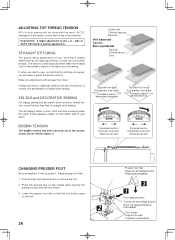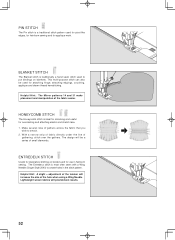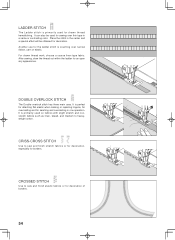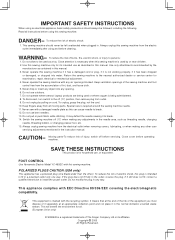Singer 7470 Confidence Support Question
Find answers below for this question about Singer 7470 Confidence.Need a Singer 7470 Confidence manual? We have 1 online manual for this item!
Question posted by Rosebautista25rb on June 5th, 2021
What Is The Cause Of My Singer Not To Stitch? I Did All The Maintenance Work And
Current Answers
Answer #1: Posted by Odin on June 5th, 2021 12:29 PM
You may have accidentally lowered the buttonhole lever located just to the left of the needle bar. To make sure it is in the correct position for sewing, place your finger under the lever and push up.
Also make sure the needle is set at the highest position and the bobbin winding spindle has been pushed back to the left.
NOTE: To set the needle at the highest position, turn the hand wheel TOWARDS you, until the needle moves to the highest position.
Finally, push the reverse button a couple of times, this will reset the machine.
If none of the troubleshooting techniques above solved the issue, please contact a SINGER Service Center to have your machine serviced.
Hope this is useful. Please don't forget to click the Accept This Answer button if you do accept it. My aim is to provide reliable helpful answers, not just a lot of them. See https://www.helpowl.com/profile/Odin.
Answer #2: Posted by SonuKumar on June 5th, 2021 9:39 PM
https://www.youtube.com/results?search_query=singer+7470+confidence+sewing+machine
https://www.youtube.com/watch?v=vzj2QG8yc_g
https://www.youtube.com/watch?v=iafvkrXHYkA
https://www.youtube.com/watch?v=04jMgPN2fx8
https://www.youtube.com/watch?v=5HiUR5Y5EVo
https://www.youtube.com/watch?v=ueFC9-3gdo0
https://www.youtube.com/watch?v=2oMrUtIa51c
If Thread Loops Are Showing on the Underside of the Fabric
Thread looping on the underside of the fabric is always an indication that the upper thread is not correctly threaded. This happens when the upper thread is not correctly placed in the tension mechanism and has not been threaded through the take-up lever. To resolve this, rethread the machine, making sure to first raise the presser foot lifter and raise the needle to its highest position, so that the thread can be properly seated in the tension mechanism and take up lever.
f Thread Is Shredding
Thread can shred when you sew if it is old or poor quality. Thread can also shred if the machine needle is worn out, or if the needle is the wrong style and size for the thread being used. The thread should pass freely through the eye of the needle in order to sew properly. Use threads that have a smooth, even filament.
If Fabric Is Not Feeding Properly
If the machine is not feeding fabric when you start sewing, it could be that the presser foot lifter has not been lowered before stepping on the foot controller. Lower the presser foot and resume sewing.
Another reason the machine may not be feeding fabric is that the feed dogs (or feed teeth) are disengaged, so make sure that they are properly engaged for sewing. (Note: If your machine has drop feed, resume normal sewing by moving the drop feed lever to regular sewing mode, then turn the hand wheel toward you one full revolution to re-engage the feed dogs).
The machine may also not feed fabric if the stitch length control is set to "0". Increase the stitch length setting and resume sewing.
If Needles Are Breaking
Needles can break if they are bent, dull or damaged. Discard the old needle and insert a new needle, appropriate for the thickness and type of fabric being sewn.
Needles can also break if you are "pushing" or "pulling" the fabric while sewing, as this causes the needle to deflect. The feed dogs (or feed teeth) are actually designed to do the work of drawing the fabric under the foot as you sew - you just need to guide the fabric!
If Upper Thread Is Breaking
If the upper thread is breaking, it could be that the thread path is obstructed, the machine is not correctly threaded or the upper thread tension is set to tightly. Be sure that the machine is correctly threaded and there are not obstructions (for example, thread getting caught behind the spool cap or a "rough spot" on the spool itself). Check also that the upper thread tension control is set correctly (consult your machine manual).
If Stitches Are Skipping
If your stitches are skipping on the fabric as you sew, this could be an indication that the needle was inserted incorrectly. Make sure that the needle goes all the way up into the needle clamp and that the flat side (at the top section of the needle) is facing toward the back.
Another reason stitches can be skipping is if the needle is the wrong style for the fabric. For instance, if you are sewing a stretch knit fabric using a regular point needle, you could be experiencing skipped stitches. Switching to a ball point needle will prevent stitches from skipping on stretch knit fabrics.
Worn out or damaged needles can also cause skipped stitches on a variety of fabric types. Discard the needle and insert a new one, appropriate for the fabric you will be sewing.
If Stitches Appear Distorted
Stitches can appear distorted on the fabric if you are "pushing" or "pulling" the fabric as you sew. Just let the feed dogs (or feed teeth) do the job of drawing the fabric along under the foot.
Another reason stitches could appear distorted is if the incorrect presser foot is used. For example, dense stitches usually require the use of either a Satin Foot or Open Toe Foot, so that the stitching can pass freely underneath. If the regular, All-Purpose Foot is used for dense stitching, stitches could get "stuck" under the foot. Just switch to a presser foot more appropriate for these types of stitches.
Please respond to my effort to provide you with the best possible solution by using the "Acceptable Solution" and/or the "Helpful" buttons when the answer has proven to be helpful.
Regards,
Sonu
Your search handyman for all e-support needs!!
Related Singer 7470 Confidence Manual Pages
Similar Questions
The Bobbin Winder stops after 4 seconds the screeches, why?
hi my singer 7470 which i just recieved is making a beeping sound every time i press the pedal and i...
Error message E7 is up on my Singer Stylist model 7258 sewing machine. It is not working at all. I t...
My sewing machine will beep and stop sewing after three inches of sewing. I have taken it to be repa...
I stopped sewing for a minute and tried to start again. The machine will beep twice and post no erro...






















